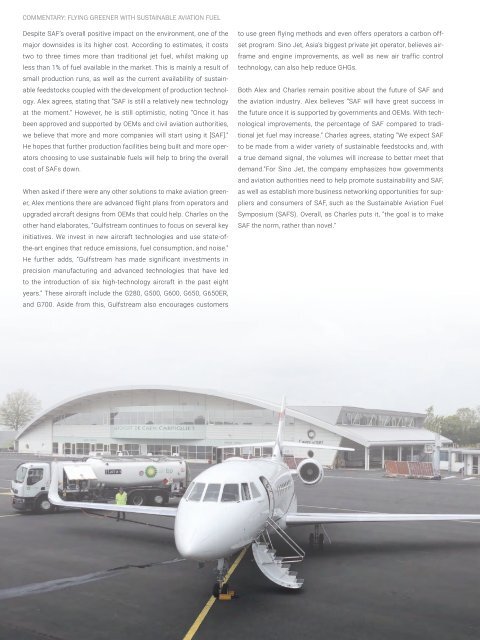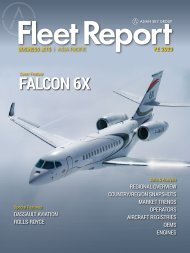Asian Sky Quarterly 2021 Q3
You also want an ePaper? Increase the reach of your titles
YUMPU automatically turns print PDFs into web optimized ePapers that Google loves.
COMMENTARY: FLYING GREENER WITH SUSTAINABLE AVIATION FUEL<br />
Despite SAF’s overall positive impact on the environment, one of the<br />
major downsides is its higher cost. According to estimates, it costs<br />
two to three times more than traditional jet fuel, whilst making up<br />
less than 1% of fuel available in the market. This is mainly a result of<br />
small production runs, as well as the current availability of sustainable<br />
feedstocks coupled with the development of production technology.<br />
Alex agrees, stating that “SAF is still a relatively new technology<br />
at the moment.” However, he is still optimistic, noting “Once it has<br />
been approved and supported by OEMs and civil aviation authorities,<br />
we believe that more and more companies will start using it [SAF].”<br />
He hopes that further production facilities being built and more operators<br />
choosing to use sustainable fuels will help to bring the overall<br />
cost of SAFs down.<br />
When asked if there were any other solutions to make aviation greener,<br />
Alex mentions there are advanced flight plans from operators and<br />
upgraded aircraft designs from OEMs that could help. Charles on the<br />
other hand elaborates, “Gulfstream continues to focus on several key<br />
initiatives. We invest in new aircraft technologies and use state-ofthe-art<br />
engines that reduce emissions, fuel consumption, and noise.”<br />
He further adds, “Gulfstream has made significant investments in<br />
precision manufacturing and advanced technologies that have led<br />
to the introduction of six high-technology aircraft in the past eight<br />
years.” These aircraft include the G280, G500, G600, G650, G650ER,<br />
and G700. Aside from this, Gulfstream also encourages customers<br />
to use green flying methods and even offers operators a carbon offset<br />
program. Sino Jet, Asia’s biggest private jet operator, believes airframe<br />
and engine improvements, as well as new air traffic control<br />
technology, can also help reduce GHGs.<br />
Both Alex and Charles remain positive about the future of SAF and<br />
the aviation industry. Alex believes “SAF will have great success in<br />
the future once it is supported by governments and OEMs. With technological<br />
improvements, the percentage of SAF compared to traditional<br />
jet fuel may increase.” Charles agrees, stating “We expect SAF<br />
to be made from a wider variety of sustainable feedstocks and, with<br />
a true demand signal, the volumes will increase to better meet that<br />
demand.”For Sino Jet, the company emphasizes how governments<br />
and aviation authorities need to help promote sustainability and SAF,<br />
as well as establish more business networking opportunities for suppliers<br />
and consumers of SAF, such as the Sustainable Aviation Fuel<br />
Symposium (SAFS). Overall, as Charles puts it, “the goal is to make<br />
SAF the norm, rather than novel.”<br />
44 | ASIAN SKY QUARTERLY — THIRD QUARTER <strong>2021</strong>

















